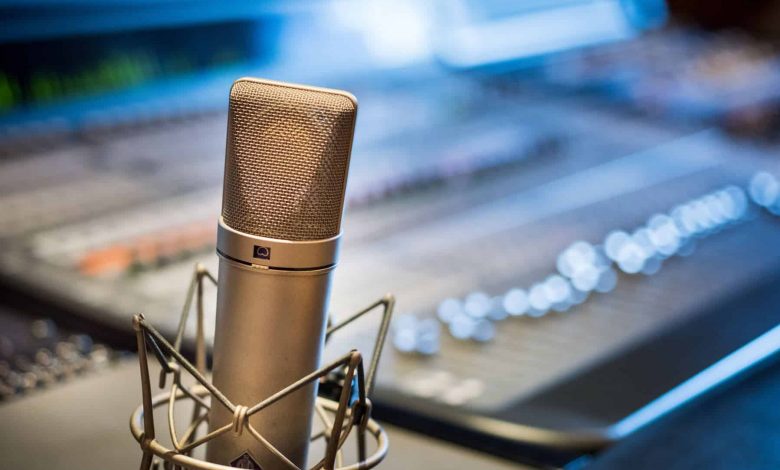Types Of Microphones – You Need To Know

Introduction
Whether it’s for your personal needs like a home studio or professional music production, microphones are an indispensable tool. However, choosing from the plethora of options on the market can be intimidating if you don’t know where to start.
To make your search a little easier, we have explained the main uses and features of 4 types of microphones. These four types are the overarching categories under which specific products will fall.
To find the perfect gear for your requirements, begin by understanding the basic functions of the microphones listed below.
Types of Microphones
Dynamic Microphone
Dynamic microphones, such as the Shure Beta 57a, are a reliable pick if you want to own an adaptable and versatile mic. Their system includes a moving coil magnetic diaphragm that ensures their effectiveness. Their technical functioning is the exact reverse of speaker operations.
As a result of this feature, sounds transmitted at high-pressure levels are efficiently captured.
If you want to capture louder sounds from guitar amps and bass, dynamic mics are perfect for you. They are ideal even for drum kits without any risk of damage or undesirable distortion.
Apart from high sound pressure level recordings, these mics are great for calmer scenarios as well. Overall, since they are durable, you can count on them for most types of recordings.
Advantages
Dynamic mics are great at recording louder music like rock vocals. This is because they don’t let distortions ruin the quality of the recording.
Their durability makes them ideal for chaotic recording scenarios. For example, if the band accidentally knocks them over, dynamic mics won’t succumb to damage.
Unlike condenser microphones, these are priced more reasonably. This is the reason a lot of musicians choose dynamic mics to start with.
Disadvantages
If you are looking to capture ranges of frequencies, dynamic mics won’t please you much. They can’t effectively pick up higher and lower frequencies. This makes them ineffective for more nuanced recording purposes.
As opposed to condenser mics, dynamic mics can’t capture sound as smoothly. This translates into recordings that aren’t filled with as much richness as those with condensers.
Large Diaphragm Condenser Microphones
Both large and small diaphragm mics are condenser mics. These mics create electric currents by converting acoustic vibrations through the use of a condenser or capacitator. Due to their design, they require 48V phantom power or similar power sources.
Larger diaphragm mics are better for picking up on air vibrations. Since the diaphragm is bigger, the magnitude of vibrations captured is also larger. Not to mention, the details of sounds are reproduced with better quality.
Large diaphragm mics are easier to manoeuvre as well. Their greater mobility and flexibility gives them the ability to pick up the minutest sound pressure differences. As a result, the sound produced is more natural and authentic.
These types of mics are popular in recording studios thanks to their trueness to fidelity. Additionally, this design is most commonly used for novel USB mics.
Advantages
Overall, condenser mics have greater sensitivity as compared to other types of mics. They also give out louder signals than ribbon or dynamic mics. Given their sensitivity, they are suitable for vocals and other dynamic sound sources.
Not to mention, larger diaphragm mics have a sleek and stylish look. They are commonly used in recording studios due to their full sound and professional quality.
While they are ideal for quieter sound sources, they can be used for all kinds of setups. Large diaphragm condenser mics are the one mic that will serve all your diverse microphone needs.
These mics come with different polar patterns that you can select from. This is a unique feature in modern large diaphragm mics and one that makes them ideal for customized requirements.
Disadvantages
Although you can use them for recording most types of sounds, the volume must be managed. They have a tendency to distort sound if the sound pressure level is on the higher end.
Small Diaphragm Condenser Microphones
The other kind of condenser mics is the smaller diaphragm mic. These are also commonly referred to as pencil pics due to their compact cylindrical build.
Thanks to their smaller size, these mics are portable and easy to position. Their construction adds stiffness in order to improve their capacity. They are thus suitable for high sound pressure levels.
They also have a larger dynamic range despite their size. As a result, small diaphragm mics are perfect for recording hi-hats, acoustic guitars, cymbals, and more.
Advantages
These mics are consistent in their ability to capture sounds. They are smaller in size, but the transient response is impressive.
You can count on these mics for the purpose of realistic stereo recordings. Additionally, you can record acoustic instruments without worrying about sound quality.
Disadvantages
On the flip side, these mics present the disadvantage of lower sensitivity. Small diaphragm mics tend to have greater internal noise production as well.
Ribbon Microphones
Ribbon microphones have been hugely popular in the past. They were widely used by radio jockeys and for other recording needs. However, they are no longer as relevant today as far as widespread usage goes.
Their construction includes a delicate metal ribbon that captures the velocity of air in addition to the air displacement. The thin ribbon is made of electro-conductive material and generates a signal from its location between two magnetic poles.
Thanks to their intricate construction, ribbon mics are built to pick up on higher frequencies. They are also designed for sensitivity to higher notes while eliminating unwanted sharpness. The overall sound recorded has a vintage and warm tone.
Nowadays, modernized ribbon mics for production purposes have made a comeback. They are more durable than the older versions. Thus, you can rely on them for sturdiness during live recordings with multiple instruments and sound sources.
Mostly, they are suitable for locations where the noise level is kept moderate.
For certain interesting and versatile soundtracks, ribbon mics are used in combination with other types of mics. They are also used for getting an especially vintage finish on your recordings.
Advantages
The high end sounds you are looking to capture will be much smoother and warmer when recorded.
Harsher and sharper instruments like trumpets and violins can be perfectly captured by ribbon mics. Ribbon mics are ideal for sound sources like drums, guitar amps, or brass.
A perfect figure 8 polar pattern is made by these mics. Additionally, ribbon mics are highly receptive and responsive to EQ.
Not only are ribbon mics vintage in their recording capabilities, but also in their look and feel. This gives them an elegant appearance if you are picky about aesthetics.
Disadvantages
Older ribbon mics are very delicate and thus vulnerable to damage. They can break easily if you move them too much or accidentally drop them.
Ribbon mics are unsuitable for louder sounds. Older models are so sensitive that the ribbon can be damaged or break if exposed to high sound pressure levels. These models are also prone to breaking in phantom power is applied.
Relatively speaking, ribbon mics are more expensive than other types of mics.
Endnotes
While every mic will have its own advantages and disadvantages, it is up to you to choose accurately. The right mic will be able to pick up on the range of sounds that you need to capture. Additionally, it will deliver on the durability you require and fall within your budget.




